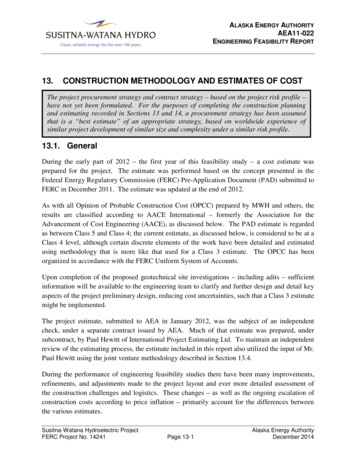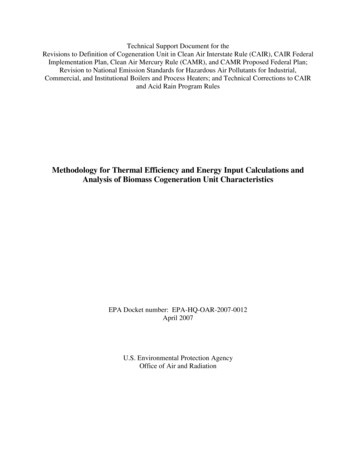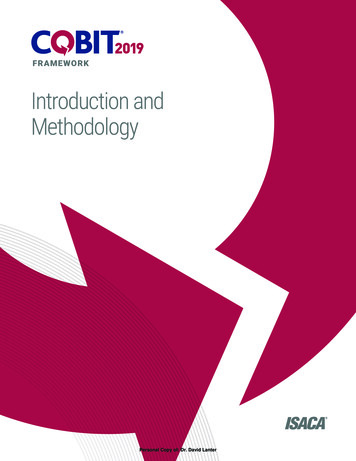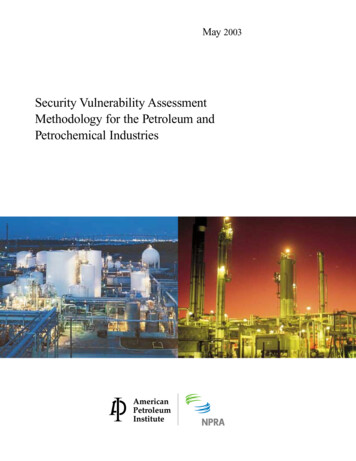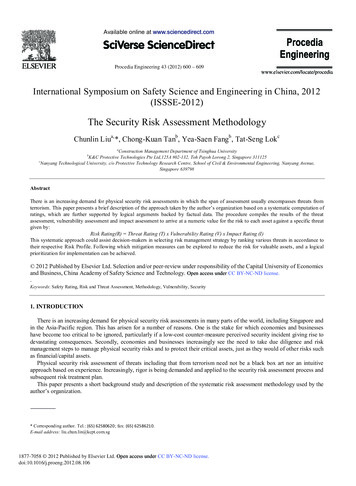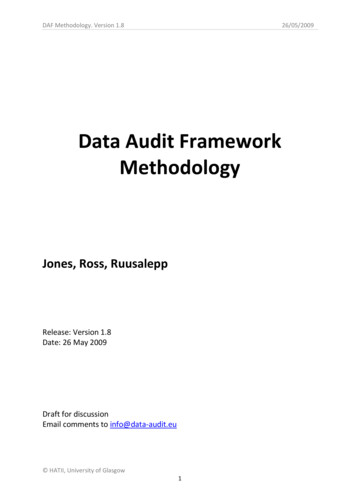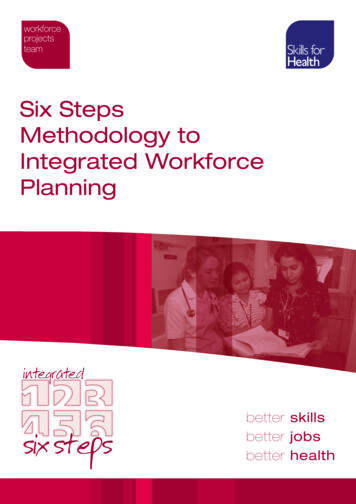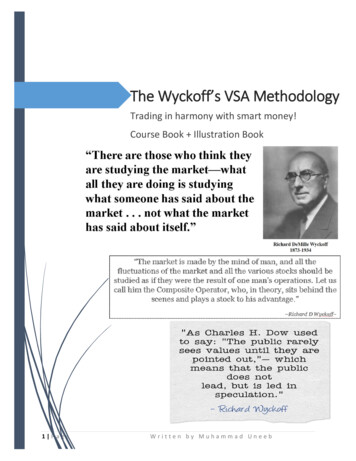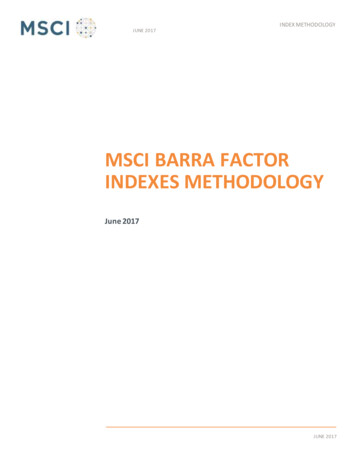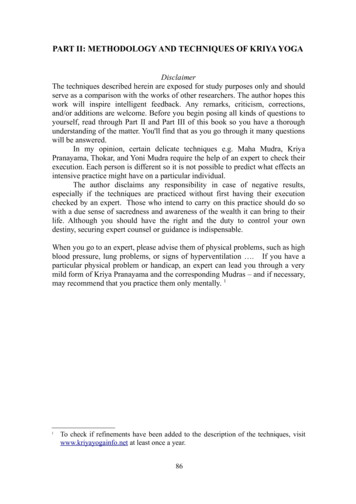
Transcription
PART II: METHODOLOGY AND TECHNIQUES OF KRIYA YOGADisclaimerThe techniques described herein are exposed for study purposes only and shouldserve as a comparison with the works of other researchers. The author hopes thiswork will inspire intelligent feedback. Any remarks, criticism, corrections,and/or additions are welcome. Before you begin posing all kinds of questions toyourself, read through Part II and Part III of this book so you have a thoroughunderstanding of the matter. You'll find that as you go through it many questionswill be answered.In my opinion, certain delicate techniques e.g. Maha Mudra, KriyaPranayama, Thokar, and Yoni Mudra require the help of an expert to check theirexecution. Each person is different so it is not possible to predict what effects anintensive practice might have on a particular individual.The author disclaims any responsibility in case of negative results,especially if the techniques are practiced without first having their executionchecked by an expert. Those who intend to carry on this practice should do sowith a due sense of sacredness and awareness of the wealth it can bring to theirlife. Although you should have the right and the duty to control your owndestiny, securing expert counsel or guidance is indispensable.When you go to an expert, please advise them of physical problems, such as highblood pressure, lung problems, or signs of hyperventilation . If you have aparticular physical problem or handicap, an expert can lead you through a verymild form of Kriya Pranayama and the corresponding Mudras – and if necessary,may recommend that you practice them only mentally. 11To check if refinements have been added to the description of the techniques, visitwww.kriyayogainfo.net at least once a year.86
CHAPTER 6LAHIRI MAHASAYA'S KRIYA YOGA – FIRST PARTINTRODUCTIONThe techniques of Kriya Yoga are explained in the second and in the thirdpart of this book. Other interesting subjects like the value of the DevotionalPrayer or the Kriya of the cells are dealt with in the fourth part of the book.The second part of the book is addressed to the persons who are curiousabout the details of the original Lahiri Mahasaya's Kriya and about thatform of Kriya taught by Swami Hariharananda.First we discuss Lahiri Mahasaya's Kriya. It's a Kriya that in my opinionoriginates from Tantric Hatha Yoga and from particular discoveries madeby Lahiri Mahasaya himself. Sufi mystics with their Dhikr give a hugecontribution. This Kriya is a set of very effective methods. If you want apractical guide to metabolize them, utilize chapter 12.In chapter 6 the basic technique of Kriya Pranayama is introduced. Inchapter 7 you find the description of all the techniques which aretraditionally part of First Kriya. In chapter 8 we introduce the Second,Third and Fourth Kriyas. This is altogether the art of Thokar. In chapter 9we introduce the Fifth and the Sixth Kriyas. This is the art ofTribhangamurari movement.In chapter 10 we discuss Swami Hariharananda's Kriya. This Kriya isinfluenced by the Radhasoami movement. Entering the Omkar dimensionplays a predominant role.The persons already initiated into the Kriya taught by the organizationsinspired by PY's teachings will find food for thought in chapter 11 –chapter 11 completes the second part. They can try to understand the reasonwhy PY decided to make some modifications in the Kriya techniques. PY'sKriya path has an unprecedented simplifying power. If the mind of thereader is open, a very important understanding will happen.Chapter 12This is the third part of the book. It contains what I judge essential. In myopinion, a novice self-taught man may start his Kriya practice from here.This part envisages 8 essential routines to be mastered in a pair of years.Such a beginner will first face the technique of Kriya Pranayama as it was87
taught by Sri's Mukherjee. This technique is not difficult to learn. Coupledwith 4 techniques that do not belong to classic Kriya Yoga and that aretaught in chapter 12, guarantees a fantastic result. In writing this chapter Iutilized my personal experience to envisage a good plan of practice.Note about the different levels of Lahiri Mahasaya's KriyaFirst LevelThe first level of this Kriya is grounded on the technique of KriyaPranayama. Normally each session opens with a short preparation andends with a phase that many call ''Meditation'' but it would be more correctto call ''Pratyahara'' that means ''withdrawal of the senses.'' After thistransition phase, a kriyaban is open to a dimension that is beyond the mind.In the first level we achieve the melting together of the energies Prana andApana. A particular state happens in our consciousness. Lahiri Mahasayacalls it Equilibrium; it is situated half road between the awareness of theexternal reality and the awareness of the internal state of peace.Before starting the practice of Kriya Pranayama, the Nadis Ida andPingala are partially blocked and the Prana has difficulty to flow.Through this condition of Equilibrium the state of Prana in the bodychanges. It becomes possible guiding our Prana in the subtle channel ofSushumna.A good signal that the breath has become "subtle" is given by a particularrealization: during the exhalation we feel that our breath doesn't go out ofthe body through the nostrils but travels within, filling with fresh energythe cells of the body.In the first level, the obtainment of Kechari Mudra is undoubtedly of greatvalue since it creates perfection in Kriya Pranayama and calmsenormously the functions of the mind. Other events can happen during themonths or the years when you one is busy with the first level. Otherprocedures come in handy, even if they are not, because of inexperience,used in every aspect of their power.Second LevelIn this level we consider a very subtle work upon the Chakras and a strongwork upon the heart Chakra. The Chakras are not an obstacle, we do notwant to entertain here any negative concept of them. But we know that our88
duty is not only to awake them but go beyond them. This is the realmeaning of the Second Level. We shall utilize the power of Thokar whichis directed toward the heart Chakra – this will happen also in the Thirdlevel of Kriya, in greater dimensions.In the Second Level, the mental pressure of Prana upon each Chakrabecomes stronger. A positive transformation is noticed in the practice ofKriya Pranayama which becomes more solid.Third LevelThe Third level of Kriya is devoted to the practice of Thokar using a longKumbhaka (holding of the breath.) Here a kriyaban exerts a very greataction on the Chakra of the heart. Knowing that the heart is the place in thebody where the traditions says that the immortal Self resides, some schoolsof Kriya consider this as the last level of Kriya. They don't know otherlevels of Kriya.There is no doubt that through a great, long, work with this ThirdLevel of Kriya no other technique is necessary. There is a strongconnection between the heart Chakra and Kutastha. The bright point(Bindu) that appears in the heart Chakra during the practice of the Thirdlevel of the Kriya is the same reality that appears as a white star in thecenter of Kutastha. Entering the star of Kutastha crossing the so-called''tunnel of eternity '' or entering a deep state of ecstasy that is expressed asthe ''contemplation of the uncreated light in the heart'' (typical expressionsof the Hesychasts) embody the same event.Fourth LevelDo you want to improve at the maximum the practice of the KriyaPranayama, while the attainments regarding the Chakra of the heartremain unaltered? Then you must practice the Fourth Level of Kriya whereThokar is applied on all the Chakras.It has been said that if you create a great impact on the MuladharaChakra, Kundalini comes up and crosses the center of the heart bringing itspotentialities to the maximum expansion. In that state our breath is totallyinternalized, therefore Kriya Pranayama is practiced in a state very similarto the breathless state. This must be kept present when we face themysterious reality of the Macro movement TribhangamurariAnother way of living the Fourth levelPart I: Macro TribhangamurariAt this level, those who accept the teaching of Satya Charan Lahiri (one ofthe grandsons of Lahiri Mahasaya) focus their attention on a descendingenergetic flow moving towards Muladhara, but remaining outside thespine. What happens by perceiving such current is difficult to express89
because we have no words to describe a reality which is beyond mind. Thislevel is a prosecution of the previous level but seems to belong to anotherword.Part II: Micro TribhangamurariThe door of the spine is opened. Now we can meet the subtle transcendentOmkar reality in the aspect of micro movement sensation. I do not ventureto indulge in rhetoric quotations of ancient holy writings. I can only saythat through this procedure we become able to leave the dimension of timeand space and reach the highest Asamprajnata Samadhi which leads toKaivalya state.Note about Swami Hariharananda's Kriya visionFirst LevelPractically speaking, this is the stage in which, mainly through simpleprocedures (among which a great place is given to Forward Bendings andMaha Mudra), a kriyaban succeeds in perceiving the astral sounds, lightand a moving sensation inside each Chakra, while the perceptions of theexternal world diminish in power. Through the daily repetition of this formof meditation, kriyabans enters the channel of Sushumna deepening theircontact with the Omkar reality.Second LevelThis level is more mysterious, because in it we dissolve the obstaclesrepresented by the Tattwas (five elements.) By referring to the well knowntheory of the five elements, we understand that our duty is to dissolve thedeceptive reality that is at their basis. We must reach the realization thatevery aspect of the physical reality is made of one only substance: theSpiritual Light. The five Tattwas (earth, water, fire, air, ether) are anillusion.Working with this ideal in mind, a kriyaban drives the Prana fromthe body toward the spine and inside the spine. Through the help ofconcentration, utilizing also a particular tool like the repetition of theletters of the Sanskrit alphabet on the ''petals'' of the Chakras and ondifferent parts of the body, the Prana gets sucked in the upper part of thehead. A kriyaban enjoys an ecstatic state and is ready for the last work thathappens in a new dimension having its seat in the upper part of the brainand over it.Third LevelIn this level a work is started to pacify the Prana in the crown of the head.Some movement of the head are still necessary.90
Fourth LevelIn this level, immobility in the whole body, head included, is established. Adeep concentration, that gradually becomes effortless, happens in the fiveparts of our head: frontal, left, back, right and under Fontanelle. 2 Then themind is lost and the estatic state ensues.Fifth LevelA simple instruction is given to reach the perfect breathless state. Theawareness of a kriyaban is not only on the calm Prana in the body but alsoover the body. A new center over Sahasrara is revealed. The mind is lostin the divine Light, over Sahasrara and gradually comes down inCerebellum.Sixth LevelThere are two ways of describing this level. One is to say that we reach theBrahma Randra which is the subtlest aspect of Bindu – a place beyondtime and space. Another way is to say that we reach the abode of thespiritual Light of God which is in the pineal gland.ConclusionIn Lahiri Mahasaya's Kriya we work to bring the Light of the Spirit in allthe parts of our being. Each Chakra is awakened, each Chakra isconsidered spiritual.In Swami Hariharananda's Kriya we find a tendency to escape from whatin Lahiri's Kriya is considered a duty: to face our human nature and livemore in the heart and less in the brain. In Swami Hariharananda's Kriyawe don't find that huge work upon the region of the heart. There is thetendency to move the center of our awareness in the higher regions of theastral dimension.In both paths we have wonderful procedures to reach the region situated inthe highest part of the brain where we can experience the dimension ofgreat, deep peace. Our heart is full of inexpressible joy. But this joybecomes alienation if is not supported by a work upon the heart and,finally, upon the basic Chakra Muladhara.It is inspiring to read the words that Lahiri Mahasaya has left in his diaries.2To locate such point, raise the chin, focus your attention where the divine Lightseems to originate.91
''The breath is normally externally oriented. If, through the practice ofPranayama it is made internally oriented, then it is possible, through thetechnique of Thokar, to open the door of the internal temple. With aforceful impact upon the Anahata Chakra the door opens. A deepengrossment occurs and this state becomes stable for a prolonged period.By achieving this state the mind becomes saddened by seeing the sufferingin others.'' (Lahiri Mahasaya)This sentence is the summary of Lahiri Mahasaya's Kriya with its differentphases. After obtaining the perfection in Pranayama it is possible to obtainthe fruit of Thokar. The door finally opens and. ''the mind becomessaddened by seeing the suffering in others.'' The promise of LahiriMahasaya is to become one with humanity [you cannot become one if youdo not feel the suffering in other human beings.]Identifying the Sahasrara Chakra with our supreme goal means to follow arefined illusion. Reaching the Brahma Randra, o the pineal gland. doesnot mean having achieved our final goal but only an intermediary phase.The true destination is the "Uncreated Light" (so said the Hesychasts) inthe region of the heart. The obsession about always holding the mind in theSahasrara region has produced people full of Ego that have lost contactwith the reality of the life and have become fix in behaviors and theoriesthat are the caricature of the spiritual path.In my life I
Chakra, Kundalini comes up and crosses the center of the heart bringing its potentialities to the maximum expansion. In that state our breath is totally internalized, therefore Kriya Pranayama is practiced in a state very similar to the breathless state. This must be kept present when we face theFile Size: 2MBPage Count: 81


